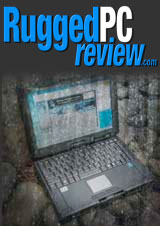|
RuggON VM-521
Ultra-rugged, super-solid Intel Bay Trail-powered 10.4-inch Windows vehicle mount computer
(by Conrad H. Blickenstorfer)
Taiwan-based RuggON Corporation was established in 2014 as a provider of ruggedized computing products. RuggON's stated mission is to raise the productivity of rugged computing solutions through creative, pioneering technology. Their lineup consists of RuggPAD tablets and RuggVMC vehicle mounts. We've had a chance to review the ultra-rugged RuggON VM-521 10.4-inch vehicle mount computer that's part of the company's RuggVMC line. This report represents a detailed hands-on description and analysis of the VM-521.
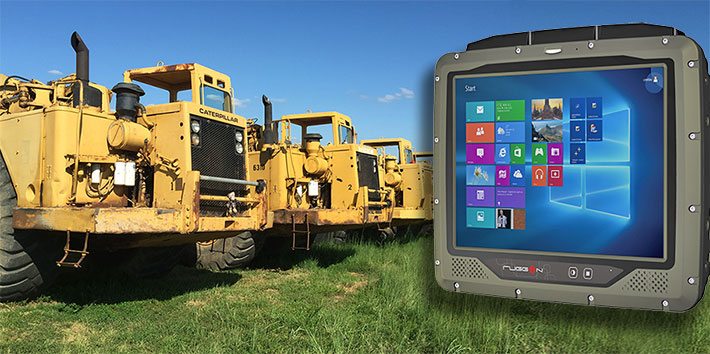
First the obvious question: Why does a company that specializes in rugged mobile tablets also offer a separate vehicle-mount computer? With so many good mounting options available, doesn't it make more sense to simply use rugged tablets in vehicles? Those could easily be removed from their docks and also used in the office or in the field. Answer: That's indeed a good option for many deployments, but not for all. Often, a computer is meant to be used in the vehicle and only in the vehicle. And it must not be a compromise. It must be as tough and solid as the vehicle itself. Weight doesn't really matter, because it's not carried around. And battery life doesn't matter because it is on vehicle power. That means that if a computer in a vehicle must be built like a tank because it must be able to endure the same punishment as a tank, it can be built like a tank.
RuggON VM-521: design and concept
While bringing tablet computer functionality into any cockpit, the RuggON VM-521 is designed from the ground up as a vehicle mount-system. It looks like a tablet when viewed from the front, but if that's so, then this is indeed a tablet built like a tank. Solid metal construction, even if it is lightweight aluminum alloy, adds up to about 8.5. That's three to four times as heavy as your typical rugged mobile tablet these days (albeit, amazingly, only half as much as Apple first laptop from back in 1989!).
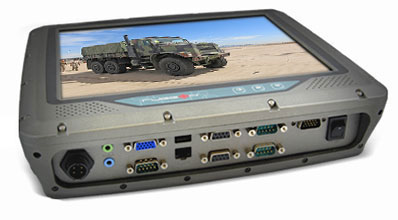 The VM-521 has a compact footprint of 10.8 x 9.9 inches, and it's about 2.7 inches thick. Unlike many panels and vehicle-mounts, the VM-521 is all cast metal and not a steel box with a plastic front panel. It's an elegant, handsome design with plenty of attention to detail and good industrial design. Surface treatment of the entire device is a warm gray with a very fine spray-paint finish. The VM-521 has a compact footprint of 10.8 x 9.9 inches, and it's about 2.7 inches thick. Unlike many panels and vehicle-mounts, the VM-521 is all cast metal and not a steel box with a plastic front panel. It's an elegant, handsome design with plenty of attention to detail and good industrial design. Surface treatment of the entire device is a warm gray with a very fine spray-paint finish.
Like all vehicle-mounts, the VM-521 runs on vehicle power, and it can accommodate a wide range of available voltages. Most vehicle-mounts have some sort of internal backup to handle vehicle power fluctuations or move to another vehicle but those usually only last a few minutes. The VM-521's internal battery, on the other hand, is good for over two hours of operation.
As is usually the case in vehicle-mounts, all I/O is facing downward for easy, efficient mounting in vehicles or fixed locations. The housing also has no fewer than 20 pre-drilled screw holes for various mounting methods. Below is a look at the VM-521 from the front and from all four sides:
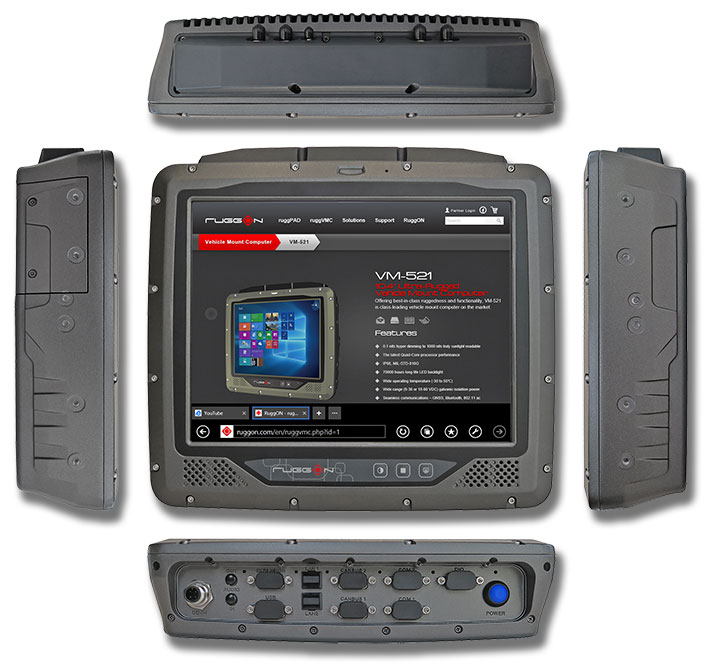
On its front, the VM-521 has powerful dual 2-watt speakers, and three physical pushbuttons (dimming, programmable function, defrost/defog), an LED that's green under normal operation, red when on battery, and off when in night mode. The RuggON logo is nicely integrated into the design, no stick-on label here. The design is complemented by 16 shiny stainless steel screws. On top of the unit is the black antenna housing for WiFi, Bluetooth and GPS.
The close-up image below shows the bottom-facing, recessed I/O area of the VM-521. There are no protective port doors like you find on most rugged tablets. Instead, unused ports can be protected with simple plastic plugs.
 The RuggON VM-521 provides the following onboard I/O, from left to right:
The RuggON VM-521 provides the following onboard I/O, from left to right:
- Industrial screw-on power connector for 9-36 or 18-60 VDC
- Audio in and out jacks
- Camera expansion port for use with optional 4-camera system

- USB (looks like DB9, but provides 2 x USB 2.0 via supplied cable)
- 2 x RJ45 Gigabit LAN jacks
- 2 x CANBUS for vehicle communication
- 1 x RS232 and 1 x RS232/485 serial
- 1 x Digital I/O (4 x in, 4 x out)
- Power on/off/sleep
On the left side of the VM-521, sitting securely behind a solid metal cover that could stop bullets, are a SD Card slot, a SIM card slot, and three dip switches, presumably for device configuration (see picture above).
Performance: Intel Bay Trail quad power
In general, fixed-mount vehicle computers are running well defined and relatively simple applications, unlike mobile tablets or laptops that may run a very wide variety of apps of different complexity. Which means hat rugged vehicle-mount computers rarely require the raw computing power of a general-purpose desktop or laptop computer or a tablet. The panel must be capable of getting the job done, but not be so powerful that heat dissipation and high cost become issues. That's called "targeted" performance — enough to efficiently running anticipated applications.
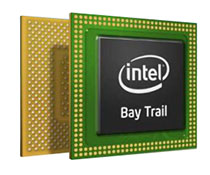 For that reason, RuggON chose the Intel E3845 processor for the VM-521. The chip is part of Intel's large "Bay Trail" family that includes Atom, Celeron and even Pentium branded processors. That's a bit confusing as Intel has traditionally used the Celeron brand largely for its barest entry level processors. That's not the case here. While all "Bay Trail" chips are based on a heavily overhauled Intel Atom architecture, they now include integrated Intel HD graphics just like Intel's high-end Core processors, albeit in a scaled down version. This gives them support for most of the same APIs and features, but without the extra cost. For that reason, RuggON chose the Intel E3845 processor for the VM-521. The chip is part of Intel's large "Bay Trail" family that includes Atom, Celeron and even Pentium branded processors. That's a bit confusing as Intel has traditionally used the Celeron brand largely for its barest entry level processors. That's not the case here. While all "Bay Trail" chips are based on a heavily overhauled Intel Atom architecture, they now include integrated Intel HD graphics just like Intel's high-end Core processors, albeit in a scaled down version. This gives them support for most of the same APIs and features, but without the extra cost.
What it boils down to is that the quad-core Atom E3845 processor powering RuggON's VM-521 vehicle-mount is much more powerful than earlier chips in fanless packages, even though its thermal design power is just 10 watts, less than that of even ultra-low voltage mobile Intel Core processors. As is, the quad-core E3845 worked out so well that the processor is being used in a large number of leading rugged tablets, panels, and embedded systems.
|
Device
|
RuggON VM-521
|
RuggON PX-501
|
Typical 2013
|
Typical 2010
|
|
Processor
|
Atom E3845
|
Core i5-5350U
|
Atom D525
|
Atom Z530
|
|
Processor Codename
|
"Bay Trail"
|
"Broadwell"
|
"Pineview"
|
"Silverthorne"
|
|
CPU base speed
|
1.91Hz
|
1.80Hz
|
1.80Hz
|
1.60Hz
|
|
CPU max turbo speed
|
no turbo
|
2.90Hz
|
no turbo
|
no turbo
|
|
Cores/threads
|
4/4
|
2/4
|
2/4
|
1/1
|
|
Lithography
|
22nm
|
22nm
|
45nm
|
45nm
|
|
Thermal Design Power
|
10 watts
|
15 watts
|
13 watts
|
2 watts
|
|
OverallPassMark
|
820
|
2,000
|
320
|
150
|
|
Overall CrystalMark
|
110,000
|
200,000
|
50,000
|
25,000
|
To provide an idea of where the quad-core E3845 stands in the overall performance landscape, consider the table to the right. It shows the VM-521 and how it compares to a top-of-the-line state-of-the-art general purpose rugged mobile tablet such a RuggON's PX-501, and also to typical panel computers from circa 2013 and circa 2010, the latter two often powered by Atom D525 and Atom Z530 processors, respectively.
The table shows the progression from single-core to multi-core processors, shrinking lithography for increased efficiency, the advent of "turbo" modes in high-end Core processors, and rapid increase in overall computing performance even at similar base clock speeds. Despite being an efficient, fanless design, the RuggON VM-521 is about five times as fast as your typical panel of five years ago, and two to three times as fast as typical panels of just three years ago.
A look inside the RuggON VM-521
The die-cast aluminum alloy housing of the VM-521 is impressive to look at, has a trust-inspiring heft to it when you pick it up, and feels all around invulnerable. The material can withstand very high operating temperatures, offers good thermal conductivity, doesn't corrode, and provides excellent EMI and RFI shielding properties. The excellent impressions continue inside. Aluminum alloy housings can be either cast or machined. Each method has its pros and cons. As is, RuggON did a fabulous job both in die-cast housing design and surface quality, which is very smooth and even, and none of the imperfections often seen in cast designs.
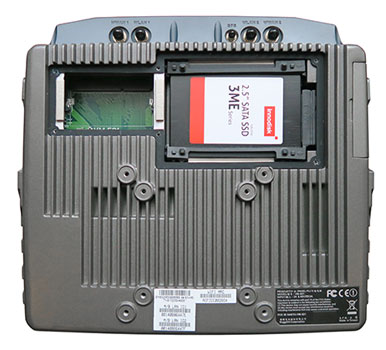 Looking at the backside of the VM-521, you see cooling fins that increase the heat-disseminating surface area of the fanless design. You see the 75mm and 100mm VESA screw hole patterns for mounting, and also a large access door. Although it's made of lightweight aluminum, it's as super-solid as everything else on this computer. The access door alone weighs more than an iPhone 6 Plus (6.9 vs 6.3 ounces). That alone tells you right there how very serious RuggON is with making this vehicle mount invulnerable. Looking at the backside of the VM-521, you see cooling fins that increase the heat-disseminating surface area of the fanless design. You see the 75mm and 100mm VESA screw hole patterns for mounting, and also a large access door. Although it's made of lightweight aluminum, it's as super-solid as everything else on this computer. The access door alone weighs more than an iPhone 6 Plus (6.9 vs 6.3 ounces). That alone tells you right there how very serious RuggON is with making this vehicle mount invulnerable.
The access door presses against a rubber seal that sticks to the body of the device, forming a waterproof seal when the cover is screwed on.
Once the door is removed, you have access to the unit's RAM expansion slot. The primary RAM slot sits perpendicular to it, and the factory-installed RAM module is secured with a dollop of glue.
Also visible is the unit's 2.5-inch SATA industrial-grade solid state disk. The SSD is shock-mounted via two rubber boots that fit over the left and right side of the SSD. Underneath the SSD is an opening that provides access to two full-size miniPCIe connectors, one marked "WWAN" and one "VIDEO."
From a design point of view, RuggON chose a "box with cover" approach, with the box part holding the majority of the circuitboards and ancillary modules, and the cover part the display and digitizer.
The front panel is secured to the main part of the housing via 16 Allen hex socket screws that not only guarantee a tight and even fit between front and back of the VM-521, but also serve as part of the design. They convey a tough, mechanical look that the VM-521 itself can back up in every way. The seal between the sides is provided by a flat two-lipped rubber pressure seal that sticks to the bottom side of the VM-521.
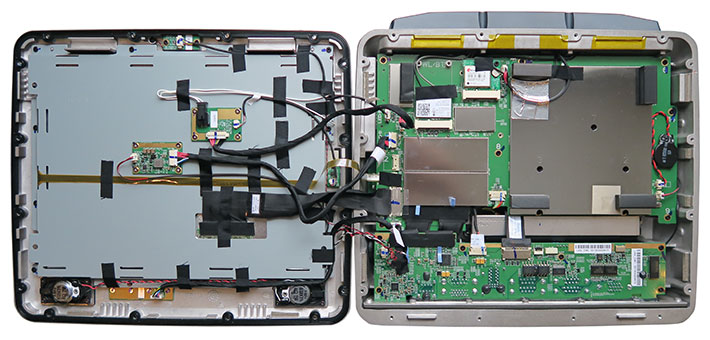
There is a significant number of wires and ribbon cables connecting the two halves, so care is advised when opening up the panel, as well as taking a picture to remember what goes where.
The VM-521's electronics are basically separated into two parts. One is the roughly 9.5 x 5 inch motherboard whose visible chips and circuits are mostly covered by metal shielding. What is visible are the unit's two miniPCIe sockets, one half-size and one full-size, that were occupied in our evaluation unit with a uBlox LEA-6N GPS module and an Intel Dual Band Wireless-AC 7260 WiFi module.
The other is an exceptionally elaborate I/O board that includes all of the unit's I/O ports in a stacked edge-mount configuration. The advantage of this full separation between motherboard and I/O, of course, is that it allows for the possibility of offering a variety of different I/O configurations. We're not sure if this is what RuggON had in mind. But since there seems to be a discrete I/O port cover (instead of pre-cut openings in the housing itself), different configurations would be easy to do.
One thing you notice inside the VM-521 is extensive use of black electrical fabric tape. It's used to bundle strings of thin wires, it's used to secure connections, and it's used to things from inadvertently making contact when they shouldn't. It's not as involved as molded integrated guides and conduits for every wire, but it's a practical solution that works.
Finally, below, some details. From left to right, the rubber pressure seal with its dual lips that goes around the entire perimeter of the VM-521, one of the two nicely sized 2-watt speakers, and the Intel WiFi module with antenna wires attached. Antennae are needed for best performance due to the thick metal housing.

Below on the left are three of the VM-521's pass-through antenna ports, each with its protective cap for when the port is not in use. On the right you can see the tough glue that keeps liquids from entering around the I/O block opening.

Very bright display
A good display is crucial in any computer, and especially so in a vehicle mount system where operators may work in the dim lighting of a warehouse or out in bright sunshine, and also in rapidly changing lighting conditions. This means that such a display must be able to adapt to a wider ambient light range than a laptop, and a much wider range than your average desktop display.
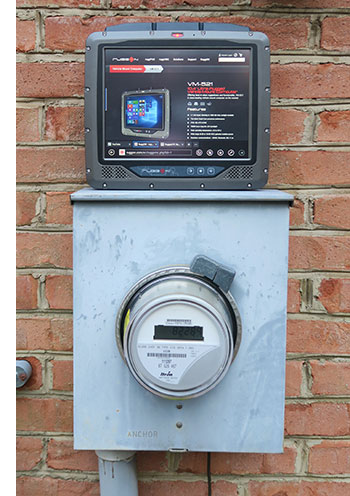 How did RuggON address the display issue? With an industrial-grade 10.4" 1024 x 768 pixel LCD and an exceptionally strong backlight. It enables a very wide range from essentially black 0.1 nits all the way to 1,000 nits. RuggON's hyper-dimming technology allows the display to be used in dark nights, and it also meets potential dim-to-black requirements a customer may have. The display also benefits from rather effective anti-reflective treatment. How did RuggON address the display issue? With an industrial-grade 10.4" 1024 x 768 pixel LCD and an exceptionally strong backlight. It enables a very wide range from essentially black 0.1 nits all the way to 1,000 nits. RuggON's hyper-dimming technology allows the display to be used in dark nights, and it also meets potential dim-to-black requirements a customer may have. The display also benefits from rather effective anti-reflective treatment.
We could not determine the LCD's origin and thus did not have access to its complete specs. Visual inspection shows a very wide horizontal viewing angle with a slight shift to yellow as the viewing angle increases, and a wide vertical viewing angle that, however, yields color shifts in the negative angles. This is less of an issue in fixed-mount vehicle computers than it would be in a laptop or tablet, because fixed-mount means the operator will look at the screen from the same angle every time. So as long as the panel is optimally mounted, color shifts won't be an issue.
Screen brightness can be adjusted from virtually off to 100% either via the Screen Brightness slider inside the Windows Power Options, or via a special hotkey utility that's brought up with one of the three physical pushbuttons on the front of the VM-521. Operators can then adjust brightness via finger taps.
As far as resolution goes, in this day and age of smartphones with full 1920 x 1080 pixel 1080p or even 4k resolution, 1024 x 768 pixel XGA may no longer seem like a lot. But consider that 1024 x 768 is what tens of millions of iPads and iPad 2s had and no one ever complained about their resolution. And the VM-521's 125 dots per inch are quite a bit sharper than the 109 dpi of the big iMac27 I am writing this review on. In addition, over the years most vertical market applications have been written and optimized for XGA.
Staying with resistive touch
Not too long ago, virtually all panel and vehicle-mount computers used resistive touch. Today, thanks to the smartphone and tablet revolution, capacitive multi-touch touch with its effortless tapping, swiping, pinching and zooming has become consumers' interface technology of choice. In the last couple of years, capacitive touch has become increasingly popular in panel computers as well.
With the VM-521, however, RuggON decided to stay with resistive touch. There are several reasons why the older resistive touch technology is preferable to capacitive touch:
First, classic Microsoft Windows was very specifically designed for use with a mouse or a pointy stylus. All of Windows' tiny check boxes, scrollers, and pulldown menus just don't work very well with capacitive finger touch. Second, standard capacitive touch doesn't work with gloves on or in the rain. Wetness doesn't affect resistive touch, and it can easily be operated with gloves. And third, it's very easy to customize and configure resistive touch interfaces, whereas that's not easily possible with capacitive touch.
It's probably for all those reasons, and perhaps others, that RuggON decided to stay with resistive touch on the VM-521. The included HIDeGalaxTouch tool allows sizing the click area, making the display beep on touch (including frequency and duration), as well as enabling "constant touch" so that the screen recognizes a push with a custom-sized area.
Operating systems
As far as operating systems go, RuggON currently lists Windows 7 Professional, Windows Embedded Standard 7, Windows Embedded 8.1 Industry Pro, Windows Embedded 8 Standard, and Linux, all 64-bit. We expect versions of Windows 10 and Windows 10 IoT to become available on the VM-521 as well. As always, the choice of OS depends entirely on the intended application and its associated software infrastructure.
 Our review machine came with Windows Embedded 8 Standard, but many customers will undoubtedly stay with Windows 7 or Embedded Standard 7 or the specialized Windows Embedded 8.1 Industry Pro. Here's some commentary on the pros and cons of OS types which those who are familiar with embedded operating systems can skip: Our review machine came with Windows Embedded 8 Standard, but many customers will undoubtedly stay with Windows 7 or Embedded Standard 7 or the specialized Windows Embedded 8.1 Industry Pro. Here's some commentary on the pros and cons of OS types which those who are familiar with embedded operating systems can skip:
A general purpose OS, like Windows 7 Professional, is just that, general purpose. You can do anything you want with it, and run anything you want on it. With that in mind, Microsoft equipped its consumer and enterprise Windows versions with all the drivers and software and utilities one could possibly need. The result is a rather large OS with numerous processes and services running all the time, all consuming storage, memory and power.
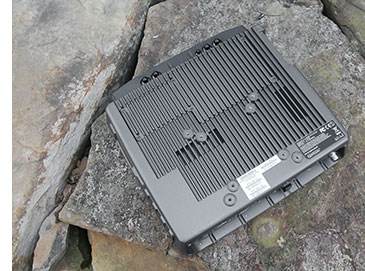 An embedded operating system is totally different. The idea is to only use what you need to perform a certain task and leave everything else behind. This greatly reduces the size of the operating system and dramatically reduces hardware requirements. Windows Embedded Standard 7, for example, is generally used for smart, connected and service oriented commercial and industrial devices that do not need all of Windows 7, yet can still run thousands of existing Windows applications. A minimum bootable image of Windows Embedded Standard 7 is just 300MB, a fraction of what full Windows 7 Professional takes. An embedded operating system is totally different. The idea is to only use what you need to perform a certain task and leave everything else behind. This greatly reduces the size of the operating system and dramatically reduces hardware requirements. Windows Embedded Standard 7, for example, is generally used for smart, connected and service oriented commercial and industrial devices that do not need all of Windows 7, yet can still run thousands of existing Windows applications. A minimum bootable image of Windows Embedded Standard 7 is just 300MB, a fraction of what full Windows 7 Professional takes.
Embedded operating systems are not one-size-fits all. A company will determine exactly what a machine is for and what it should be able to do. They then include as many components (hence the term "componentized" operating system) as they need. There are over 10,000 available and it's easy to create lean, nimble embedded OS platforms that can still do sophisticated high level tasks like advanced multimedia, browsing, communications or whatever a task requires. An embedded OS can even run as a real-time OS via third party plug-ins. Essentially you get the power of the basic Windows engine, but without any overhead you don't need. All of this is changing in Windows 10, which uses a "common core" approach with separate drivers and features for different classes of devices.
Ruggedness
The ruggedness characteristics of a vehicle-mount are inherently different from those of a rugged mobile system. Vehicle-mounts aren't carried around and thus can't be dropped, so the drop spec that's so important in hand-carried mobile devices isn't an issue. Vehicle-mounts, however, are subjected to much more vibration and shock. Operating temperature is important because it can get brutally hot and cold inside vehicle.

Available environmental specs of the RuggON VM-521 are quite impressive. The device has an extremely wide operating temperature range of -22 to 131 degrees Fahrenheit (-30 to 50 degrees Celsius).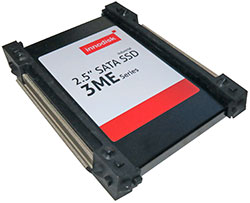 This means RuggON's tough vehicle-mount computer can be operated even in freezers and on other assignments where it will encounter very low temperatures. Since LCD displays can struggle with low temperatures, the panel has a dedicated integrated display defroster. This means RuggON's tough vehicle-mount computer can be operated even in freezers and on other assignments where it will encounter very low temperatures. Since LCD displays can struggle with low temperatures, the panel has a dedicated integrated display defroster.
In the past, rotating hard disks were one of the primary sources of failure in rugged computing systems due to temperature extremes as well as bumps and grinds that caused head crashes. Thanks to the decreasing cost of solid state storage media, SSDs have almost completely replaced hard disks in rugged computing gear, including the VM-521.
Thanks to extensive rubber-mounting, the system's speedy 2.5-inch Innodisk 3ME Series SSD is unlikely to fail. Its own operating temperature is -40 to 185 degrees Fahrenheit (-40 to 85C), and it can handle extreme shock (1,500G@0.5ms) and vibration (20G@7~2000Hz) even without rubber mounts.
Water and dust protection is at the IP66 equivalent, where the 6 stands for total protection against dust, and the 6 for protection against strong jets of water from all directions. The latter is especially important because it means a vehicle-mounted VM-521 can be hosed down with the rest of the vehicle.

As far as resistance to vibration goes, RuggON refers to the MIL-STD-810G 514.6 procedures that describe vibration exposure testing for US highway trucks (Figure 514.6C-1 Category 4), composite two-wheeled trailers (Figure 514.6C-2 Category 4), and composite wheeled vehicles (Figure 514.6C-2 Category 4).
Since ruggedness testing results can be extensive, manufacturers usually only include highlights into their tech specs. We recommend to always request all available ruggedness testing results, especially as they pertain to planned deployment of a device.
The RuggON VM-521: bottom line
With the VM-521, RuggON Corporation provides an elegant, meticulously designed and finished ultra-rugged vehicle mount computer for use in a very wide variety of deployments that require a solid, fixed-mount system. 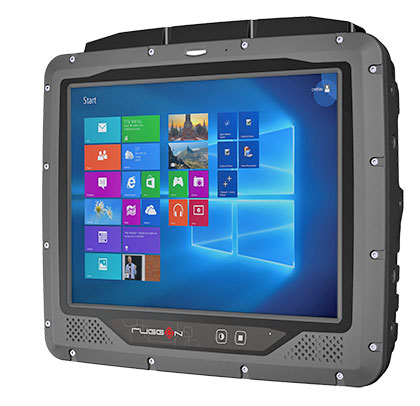 With a compact footprint that allows mounting almost anywhere, the very solid all-metal VM-521 addresses the needs of customers who require tablet computer power and functionality, but in a much more substantial package. The attractive warm-gray housing with a very fine spray-paint finish feels invulnerable and is clearly built to stand up to even the roughest handling. With a compact footprint that allows mounting almost anywhere, the very solid all-metal VM-521 addresses the needs of customers who require tablet computer power and functionality, but in a much more substantial package. The attractive warm-gray housing with a very fine spray-paint finish feels invulnerable and is clearly built to stand up to even the roughest handling.
Designed for the needs of typical vehicle applications, the VM-521 is powered by a quad-core Intel "Bay Trail" processor. The efficient chip allows a fanless device without potentially troublesome cooling fan. The VM-521 uses standard SATA/600 solid state storage, which is quicker and far less damage-prone than rotating hard disks. RuggON offers various operating system choices. Our Windows Embedded 8-based evaluation unit was quick and responsive.
The system's 1,000 nits 10.4" display is very bright and easily able to handle use in bright daylight. The display's anti-reflective treatment is effective, and the screen can dimmed all the way down to just 0.1 nits for night use. 1024 x 768 pixel XGA resolution has long been a standard in vertical market software design. 5-wire resistive touch seems the right solution for this type of device.
The VM-521 is an extremely rugged device whose IP66 sealing makes it impervious to dust and capable of being hosed off when dirty. It has an exceptionally wide operating temperature range (-22 to 131 degrees Fahrenheit), as well as a special defrost and defog heater.
The vehicle-mount offers excellent onboard connectivity via two USB 2.0 ports, dual gigabit LAN port, dual legacy serial ports, dual CANBUS ports, and digital I/O, all located in the back of the unit, facing down. There is dual-band 802.11ac WiFi and integrated Bluetooth, as well as five antenna pass throughs. The VM-521 uses external vehicle power, offering two wide-range options, and also has a powerful internal UPS backup to guard against power fluctuations and provide over two hours of battery operation.
Overall, the RuggON VM-521 is an elegant, convincing design that brings advanced computing and communication inside a wide variety of vehicles. It's compact, versatile, and feels absolutely invulnerable.
-- Conrad H. Blickenstorfer, March 2016
RuggON VM-521 Specs:
| Added/changed |
Added 08/2014, updated 09/2015, full review 03/2016
|
| Type |
Rugged Vehicle Mount PC
|
| Processor |
Quad-core Intel 1.91GHz "Bay Trail" Atom E3845
|
| Graphics |
Intel HD Graphics Gen7 (4EUs)
|
| OS |
Windows 7 Professional, Windows Embedded Standard 7, Windows Embedded 8.1 Industry Pro, Windows Embedded Standard 8, Linux
|
| Standard/Max RAM |
4GB or 8GB DDR3L SDRAM |
| Disk/drive |
64GB SATA SSD (InnoDisk 3ME Series industrial SSD) |
| Display type |
TFT with 1,000 nits luminance, LED backlight, down to 0.1 nits hyper dimming for night operation, anti-reflection coating, optional optical bonding/PCT (Gorilla Glass)/defroster
|
| Display size/resolution |
10.4-inch/XGA (1024 x 768 pixel) |
| Digitizer |
5-wire resistive touch |
| Keyboard/keys |
Onscreen, optional external
|
| Navigation |
Touch, stylus
|
| Expansion slots |
1 x SD card
|
| Housing |
Die-cast aluminum alloy
|
| Size |
10.8" x 9.9" x 2.7" (275mm x 252mm x 68mm)
|
| Weight |
3.8kg (8.4 pounds)
|
| Operating temperature |
-22° to 131°F (-30° to 55°C) |
| Ingress protection |
IP66 (totally dustproof, sealed against strong jets from all directions) |
| Humidity |
MIL-STD-810G Method 507.5 Humidity Procedure II Aggravated Cycles (Fig 507.5-7), 5 to 95% non-condensing |
| Shock |
MIL-STD-810G Method 516.6 Procedure 1 Functional Shock (40g, 11ms) |
| Vibration |
MIL-STD-810G, common carrier/composite two-wheeled trailer/composite wheeled vehicle |
| Altitude |
Unknown |
| Power |
Wide range isolated 9~36VDC or 18~75VDC, integrated battery (7.4V, 3,000mAH) |
| Camera |
None; optional 4 ports video-in (SDK included) |
| Scanner |
None |
| Sensors |
Unknown |
| Communication |
802.11ac WiFi, Bluetooth v4.0, GNSS (GPS/QZSS or GLONASS); optional WWAN |
| Interface |
2 x USB 2.0, 1 x RS422/485, 1 x R232, 2 x RJ45 LAN, 2 x CAN, 4 x DI/DO, audio in/out |
| Price |
Inquire |
| Spec sheet |
 RuggON VM-521 brochure (PDF) RuggON VM-521 brochure (PDF)
|
| Web page |
RuggON VM-521 web page |
| Contact |
RuggON Corporation
4F., No. 298, Yang Guang St., NeiHu Dist.
Taipei City 11491, Taiwan
Fax: 886-2-8797-1881
Fax: 886-2-8797-1881
Web: www.ruggon.com
info@ruggon.com
|
|
